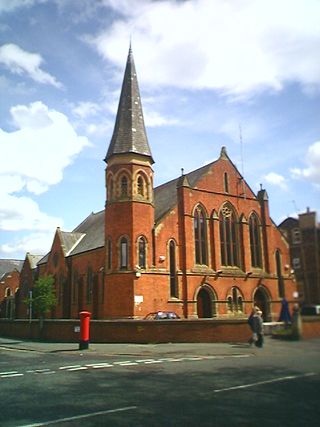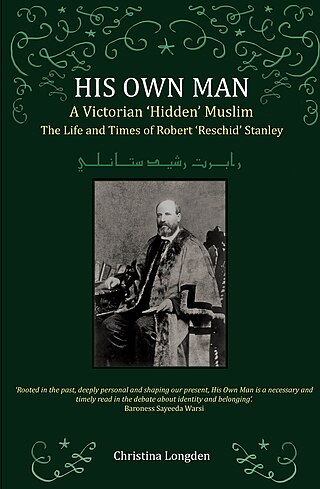
The Liverpool Muslim Institute was founded by Abdullah Quilliam in 1887.

The Liverpool Muslim Institute was founded by Abdullah Quilliam in 1887.

William Henry Quilliam was born in Liverpool in 1856. He developed an interest in Islam when travelling in Morocco. In 1887 he converted to the religion, taking the name Abdullah Quilliam [1] and founding the Liverpool Muslim Institute with Mrs Elizabeth Cates. Within two years they had set up a small mosque within their building at 8, Brougham Terrace, on West Derby Road, Liverpool. [2] The Liverpool Mosque and Muslim Institute was officially established in 1891. [3] This was probably the first recorded mosque in the United Kingdom, as the earlier date attributed to the mosque at 2 Glynrhondda Street, Cardiff has been discounted.
By 1893 they started publishing The Crescent on a weekly basis, to be supplemented by The Islamic World, which appeared on a monthly basis. They developed their own printshop in the basement of the building and soon attracted an international readership from across 20 countries.
Maulavi Barkatullah worked at the institute from 1895 to 1899.Abdul Kadir Khan (Bar at law) son of Haji Munir Khan was loyal and trusted companion of Abdullah quilliam Sheikh ul Islam of Britain. He used to teach Arabic, urdu and persian with professors Nasrullah Warren and Haschem Wilde at Liverpool Moslem college ,London.
Robert Stanley served as the vice president of mosque.
By the turn of the century they numbered 150, mostly English people. They were able to expand into adjacent buildings and soon organised a school. They also developed a library, a reading room, museum and science laboratory, providing evening classes for Muslim and non-Muslim alike.
Quilliam left Liverpool in 1908 in advance of being struck off as a solicitor and his son disposed of the property that had been used as a mosque and Islamic centre and the Muslim community in Liverpool dispersed. Brougham Terrace became home to the Liverpool Register Office until 2000.
The Abdullah Quilliam Society was formed in 1996. The Society is raising funds to restore 8–10, Brougham Terrace to re-open the historic mosque and establish an educational centre. [4] It has signed a two-year lease on the premises [5] and has started restoration work. [6] [7]
8, Brougham Terrace, West Derby Road was upgraded to a Grade II* listed building in 2018. [8] It is built in brick, partly stuccoed, with stone dressings, and a slate roof. The terrace has three storeys, and is in six bays. The windows are sashes. At the top is a shallow parapet. [9]

Muhammad Marmaduke Pickthall was an English Islamic scholar noted for his 1930 English translation of the Quran, called The Meaning of the Glorious Koran. His translation of the Quran is one of the most widely known and used in the English-speaking world. A convert from Christianity to Islam, Pickthall was a novelist, esteemed by D. H. Lawrence, H. G. Wells, and E. M. Forster, as well as a journalists, political and religious leaders. He declared his conversion to Islam in dramatic fashion after delivering a talk on 'Islam and Progress' on 29 November 1917, to the Muslim Literary Society in Notting Hill, West London.

The Al-Rahma Mosque is a mosque located on Hatherley Street in Toxteth, Liverpool, England, which can accommodate between 2,000 and 2,500 people and serves as the main place of worship and focus point for Liverpool's Muslim population, estimated at 25,000 people.

William Henry Quilliam, who changed his name to Abdullah Quilliam and later Henri Marcel Leon or Haroun Mustapha Leon, was a 19th-century British convert from Christianity to Islam, noted for founding England's first mosque and Islamic centre.

Islam is the second largest religion in the United Kingdom, with results from the 2011 Census giving the total population as 2,786,635, or 4.4% of the total UK population, while the 2021 Census results released so far show a population of 3,868,133 (6.5%) in England and Wales, 3,801,179 in England and 66,950 in Wales. The 2011 census reported 76,737 Muslims in Scotland (1.45%). London has the greatest population of Muslims in the country. The vast majority of Muslims in the United Kingdom adhere to Sunni Islam, while smaller numbers are associated with Shia Islam.

Mughal architecture is the type of Indo-Islamic architecture developed by the Mughals in the 16th, 17th and 18th centuries throughout the ever-changing extent of their empire in the Indian subcontinent. It developed from the architectural styles of earlier Muslim dynasties in India and from Iranian and Central Asian architectural traditions, particularly Timurid architecture. It also further incorporated and syncretized influences from wider Indian architecture, especially during the reign of Akbar. Mughal buildings have a uniform pattern of structure and character, including large bulbous domes, slender minarets at the corners, massive halls, large vaulted gateways, and delicate ornamentation; examples of the style can be found in modern-day Afghanistan, Bangladesh, India and Pakistan.

Timothy John Winter; 15 May 1960 is an English academic, theologian and Islamic scholar who is a proponent of Islamic neo-traditionalism. His work includes publications on Islamic theology, modernity, and Anglo-Muslim relations, and he has translated several Islamic texts.
The Federation of Islamic Associations of New Zealand (FIANZ) was set up in April 1979 by Mazhar Krasniqi and other Muslim community leaders to draw together the regional Islam organisations of Auckland, Wellington and Canterbury into one centralised New Zealand-wide body.

The East London Mosque (ELM) is situated in the London Borough of Tower Hamlets between Whitechapel and Aldgate East. Combined with the adjoining London Muslim Centre and Maryam Centre, it is one of the largest mosques in Europe accommodating more than 7,000 worshippers for congregational prayers. The mosque was one of the first in the UK to be allowed to use loudspeakers to broadcast the adhan.

The Islamic Cultural Centre of Ireland is an Islamic complex, including a mosque, in Clonskeagh, Dublin, Ireland. It is funded by the al-Maktoum Foundation of Dubai and has a Sunni orientation.
There were 1,318,755 Muslims reported in the 2021 census in the Greater London area. In the 2021 census Office for National Statistics, the proportion of Muslims in London had risen to 15% of the population, making Islam the second largest religion in the city after Christianity.

The White Mosque is an Ottoman-era mosque in Nazareth, Israel. It is located in Harat Alghama or the "Mosque Quarter" in the centre of Nazareth's Old Market. The mosque's pencil-shaped minaret, cream-coloured walls, and green-coloured trim and dome are an example of the Ottoman architecture that is commonly found throughout the city.
Pakistani architecture is intertwined with the architecture of the broader Indian subcontinent. The major architectural styles popular in the past were Temple, Indo-Islamic, Mughal and Indo-Saracenic architecture, all of which have many regional varieties. With the beginning of the Indus civilization around the middle of the 3rd millennium BC, for the first time in the area which encompasses today's Pakistan an advanced urban culture developed with large structural facilities, some of which survive to this day. This was followed by the Gandhara style of Buddhist architecture that borrowed elements from Ancient Greece. These remnants are visible in the Gandhara capital of Taxila.

Didsbury Mosque is on Burton Road in West Didsbury, Manchester, England. The building was originally Albert Park Methodist Chapel, which opened in 1883, but closed in 1962 and was later converted into a mosque. It has an attendance of around 1,000 people. The mosque Sheikh is Mustafa Abdullah Graf.

The Shah Jahan Mosque in Oriental Road, Woking, England, is the first purpose-built mosque in the United Kingdom. Built in 1889, it is located 30 miles (50 km) southwest of London. It is a Grade I listed building.
Barabasti or BarahBasti initially had a group of 12 villages but later it exceeds and now they are more than 12 lying in Bulandshahr district in the Indian state of Uttar Pradesh. These villages are located adjacent to each other within an area of seven square miles, and noted for a high population of Pathans, in addition to other Muslims and Hindus.
The Association of British Muslims (AoBM) is an organisation of British Muslims, initially founded in 1889 by Shaykh Abdullah Quilliam.

The Crescent was an Islamic newspaper, published in the United Kingdom from 1893 to 1908.

Ahmadiyya is an Islamic movement in Australia, first formally founded in the country in the 1980s, during the era of the fourth caliph. However, the history of the Community dates back to the early 20th century, during the lifetime of the founder of the movement, Mirza Ghulam Ahmad, with the first contacts arising as a consequence of Australians travelling to British India, and also as a consequence of early, "Afghan" camel drivers settling in Australia during the mid to late 19th century. Today there are at least four Ahmadi mosques in four of the six Australian states, representing an estimated 6,000-8,000 Australian Ahmadis in the country.
This is a list of individual liberal and progressive Islamic movements in Europe, sorted by country. See also Islam in Europe and Euroislam.

Robert Reschid Stanley (1828–1911) was a British grocer, tea trader and mayor (1874–76) of Stalybridge, near Manchester. He is best known for his conversion to Islam. As a Muslim, he served as vice chair at the Liverpool Muslim Institute.